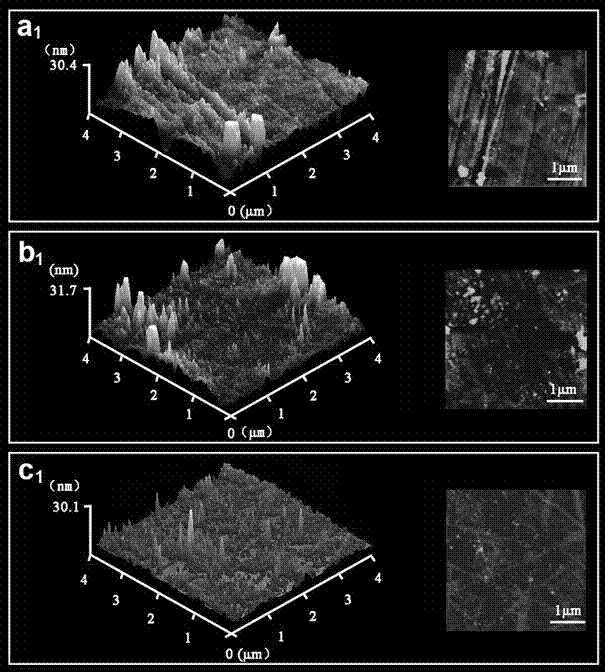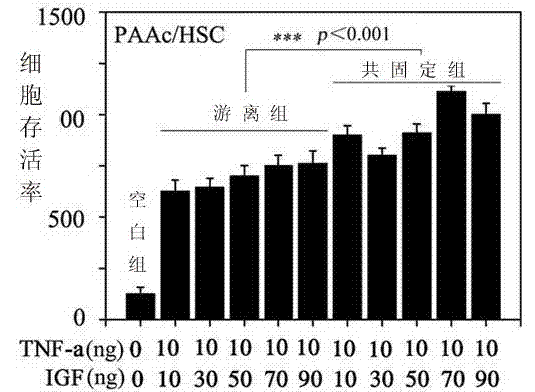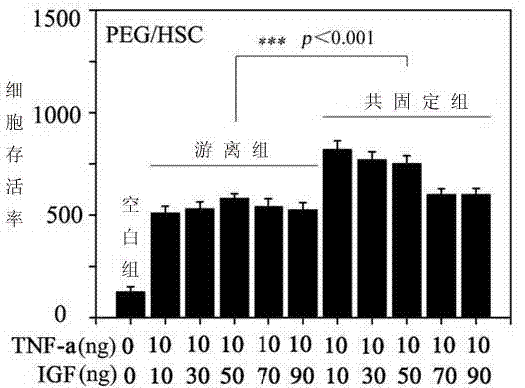Anti-liver cell aging co-fixation electric biomaterial and application thereof
A technology of biomaterials and hepatocytes, applied in the field of co-immobilization of electrical biomaterials, can solve problems such as no related reports.
- Summary
- Abstract
- Description
- Claims
- Application Information
AI Technical Summary
Problems solved by technology
Method used
Image
Examples
Embodiment 1
[0065] Example 1 Preparation of photofixed electrical material AzPhPAAc-Pst
[0066] Take 6.0mmol 1-ethyl-3-(3-dimethylaminopropyl) carbodiimide hydrochloride (WSC), 1.0mmol PAAc and 0.1mmol 4-azidoaniline hydrochloride dissolved in 110ml deionized water ; The pH of the solution was adjusted to 7.0 with NAOH or HCL, and after stirring at 4°C for 48 h, the reaction solution was dialyzed with ultrapure water through a seamless cellulose tube (cutoff MW, 12000) until the azidophenyl group in the washing liquid The content cannot be detected by ultraviolet spectrophotometer, and the derivative AzPhPAAc modified by azidophenyl group is obtained, and the monolayer polymer is freeze-dried. Under a dark environment, the obtained derivatives were formulated into a 1 mg / ml aqueous solution, and the resulting solution was placed in a 24-well polystyrene (PSt) culture plate (10 μl per well), and air-dried at room temperature in the dark. 5 ΜJ / cm 2 The intensity of ultraviolet light w...
Embodiment 2
[0067] Example 2 Preparation of photofixed electrical material AzPhPEG-Pst
[0068] 100 mg of diaminoPEG and 81 mg of N-(4-azido)succinimide were stirred overnight in chloroform to obtain a product which was purified three times by chloroform / dehydrated ether until 4-azidosuccinimide in the eluent It cannot be detected by ultraviolet spectrophotometer, and the derivative AzPhPEG modified by azidophenyl group is obtained. In a dark environment, the obtained derivatives were prepared into 1 mg / ml aqueous solution, and the obtained solution was placed in a 24-well polystyrene culture plate (PSt plate) (10 μl per well), and air-dried at room temperature in the dark. 5 ΜJ / cm 2 The intensity of ultraviolet light was irradiated from a distance of 15cm for 60 seconds, and the culture plate was placed in the solution of PH=4, the solution of PH=10 and ultrapure water, and the unreacted polymer was removed by ultrasonic wave. After washing, the plate was washed with Sterilized with...
Embodiment 3
[0069] Example 3 Preparation of photofixed electrical material AzPhPAAm-Pst
[0070] In 50ml of THF solution with 13.3g of DCCI dissolved, 150ml of THF solution with 13.3g of hydroxysuccinimide dissolved and 9.57g of 4-azidobenzoic acid were added dropwise, and the process was stirred in an ice bath; after 3 hours, the reaction solution slowly warmed up Keep stirring overnight at room temperature; the formed white liquid is filtered, and the remaining yellow residue is crystallized in isopropyl alcohol / isopropyl ether; then 10ml of an aqueous solution with 30mg of PAAm dissolved, pH 7.0, in an ice bath Add 20ml of DMF solution dissolved with 8.4mg of 4-azidosuccinimide while stirring, and after stirring at 4° for 24h, the solution is ultrafiltered and washed with 5ml of DMF / H 2 O solution was washed twice, and then 5 ml of ultrapure water was used until 4-azidosuccinimide in the eluate could not be detected by ultraviolet spectrophotometer, and the derivative AzPhPAAm modifi...
PUM
 Login to View More
Login to View More Abstract
Description
Claims
Application Information
 Login to View More
Login to View More - R&D
- Intellectual Property
- Life Sciences
- Materials
- Tech Scout
- Unparalleled Data Quality
- Higher Quality Content
- 60% Fewer Hallucinations
Browse by: Latest US Patents, China's latest patents, Technical Efficacy Thesaurus, Application Domain, Technology Topic, Popular Technical Reports.
© 2025 PatSnap. All rights reserved.Legal|Privacy policy|Modern Slavery Act Transparency Statement|Sitemap|About US| Contact US: help@patsnap.com



